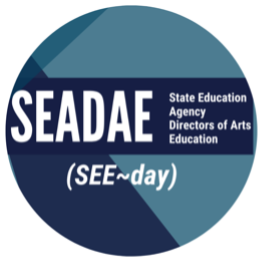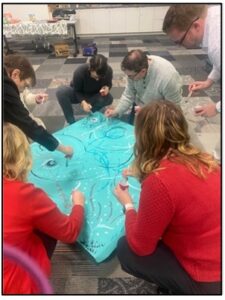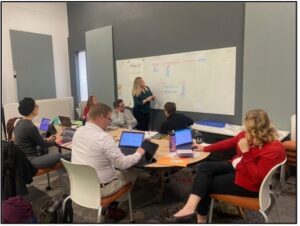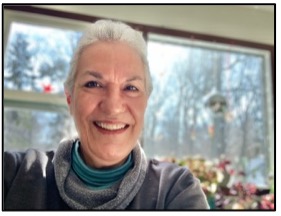 There’s no greater feeling than sensing the synergy between your brilliant best friends as they get to know each other. My best friends have alphabet soup names that reflect the broad scope of their missions, and they are:
There’s no greater feeling than sensing the synergy between your brilliant best friends as they get to know each other. My best friends have alphabet soup names that reflect the broad scope of their missions, and they are:
- State Education Agency Directors of Arts Education (SEADAE)
and
- Michigan Arts Education Instruction and Assessment (MAEIA).

SEADAE’s vision that all preK-20 students gain artistic literacy and fluency through equitable access to quality, sequential, standards-based opportunities for learning in dance, music, theatre, visual arts and media arts aligns well with MAEIA’s role as a leading state and national resource for arts education, helping to ensure that every student receives high-quality arts learning as part of a well-rounded education.
SEADAE and MAEIA first worked together in 2012 when a partnership between the two organizations allowed MAEIA to share its resources with states across the nation. These resources include:
- Michigan Blueprint for Quality Arts Education
- Research & Recommendations behind the blueprint
- The Arts Program Review Tool
- Assessment Specifications
- 360 Performance Assessments.
SEADAE was organized in 2006 and is comprised of individuals designated by state education agencies as responsible for overseeing education in the arts in their states. SEADAE’s mission is to:
- Support the professional effectiveness of individual members.
- Provide a collective voice for leadership on issues affecting arts education.
Michigan’s representative to SEADAE is Mary Head, Departmental Analyst/Interim Arts Education at the Michigan Department of Education. She is also a strong MAEIA partner. Currently SEADAE has 40 states represented with six of these states and Department of Defense schools each having more than one arts specialist and North Carolina, Georgia and Colorado having 3 arts specialists each. Michigan is part of SEADAE’s Midwest Region that also includes: Iowa, Illinois, Indiana, Kentucky, Kansas, Minnesota, Missouri, North Dakota, Nebraska, Ohio South Dakota, and Wisconsin.
 Serving since September 2023, Elizabeth Maughan, Ph.D, is the current President of SEADAE. Her term is six years including the role of both President-Elect and Past President. The President is supported by an elected board and regional representatives who help ensure dialog across the national and regional levels. In an effort to renew communications between old friends, I interviewed Elizabeth. She describes herself as a farm kid who ended up wanting to teach music. She felt, however, that her undergraduate preparation was not as strong as she would have liked so she continued her education completing a Ph.D. in music education. Since then, she’s taught general music, choir, and band before stepping into her current position as Director of Fine Arts at the Oklahoma State Department of Education. (OSDE).
Serving since September 2023, Elizabeth Maughan, Ph.D, is the current President of SEADAE. Her term is six years including the role of both President-Elect and Past President. The President is supported by an elected board and regional representatives who help ensure dialog across the national and regional levels. In an effort to renew communications between old friends, I interviewed Elizabeth. She describes herself as a farm kid who ended up wanting to teach music. She felt, however, that her undergraduate preparation was not as strong as she would have liked so she continued her education completing a Ph.D. in music education. Since then, she’s taught general music, choir, and band before stepping into her current position as Director of Fine Arts at the Oklahoma State Department of Education. (OSDE).
Moving from the classroom to the OSDE position presented a steep learning curve for Elizabeth. This is when both SEADAE and MAEIA resources came into play. When I first introduced myself to Elizabeth, she said, “I have seen MAEIA’s work and when I first started here at the OSDE I used the Blueprint for Quality Arts Program extensively. It’s a wonderful document.”
I began our conversation by asking what her goals as SEADAE’s president are?
The organization is well-established so there isn’t a lot to change organizationally, and the people have been so helpful professionally, however, it seems as if there is a lot of turn-over in state education agencies. People come and then unfortunately before too long they are gone again. SEADAE’s Executive Board is focusing on mentoring new members, providing resources to help those in state agency arts positions, and helping to keep people in those positions. The work also involves advocacy and reaching out to the agencies where there isn’t representation in SEADAE. We want to find out what the barriers are to designating a representative to SEADAE.
What big issue is SEADAE working on?
SEADAE is lucky to regularly receive National Endowment for the Arts grants to support its work. One focus of this work is providing professional support resources for state education agencies around customized arts learning. This customization would consider students and their backgrounds and experiences. It would assist arts teachers in finding arts experiences that 1) speak to the students, 2) are standards based, and 3) are embedded in the curriculum. SEADAE is currently developing a toolkit for teachers on customized arts learning with a planned launch on their website in summer of 2024. This will be followed by professional development in states launching in the fall of 2024. In 2025, the toolkit will be piloted with teachers.
Why do you think it’s important for states to be represented in SEADAE?
Member states gain a much broader understanding of arts education through convening with other state education agencies around the nation. They are introduced to exemplars to emulate, and they learn how organizations in various states are working together within the arts education ecosystem. Unfortunately, arts specialists often don’t have the same support within their departments as other disciplines and SEADAE gives these educators a place to go and people to reach out to when they have questions. In most cases, no one within the state agency knows the answer to arts education questions. SEADAE gives individuals national colleagues with which to confer.
Does SEADAE charge state agencies to participate?
There is no cost to states to participate.
What do states get out of active SEADAE membership?
SEADAE hosts regular virtual “water cooler” sessions. These professional learning sessions tackle topical subjects such as artificial intelligence (AI) and its impact on arts teaching and learning. SEADAE also hosts in person convenings every two years; and monthly meetings where members can talk about projects they are working on, receive input from around the nation, hear who else has done it, how they approached it and what resources are available to launch the work in your own state. States learn from colleagues about federal funding, approaches to federal funding, national conferences, and other opportunities.
What challenges and opportunities are ahead for arts education?
Not all members have experienced this, but teacher shortage is becoming a big problem in many states. We have districts who want to have arts programs, but they can’t find teachers. In Oklahoma, arts education isn’t required, so districts can put students in online courses if there aren’t enough students or a teacher isn’t available. Another challenge and opportunity is artificial intelligence and how it will change the profession and everything we can’t yet see. This is why SEADAE has had two “water cooler” sessions on AI and is planning for more learning areas in the future.
Do you have any parting words?
SEADAE has a strong executive committee. We have good people in arts education leadership roles across the nation. We have incredible members stepping forward and taking active roles in the organization. We look forward to having more states join. It is an honor as President of SEADAE to work with such high caliber people dedicated to the vision that all preK-20 students gain artistic literacy and fluency through equitable access to quality, sequential, standards-based opportunities for learning in dance, music, theatre, visual arts and media arts.
 As SEADAE and MAEIA move forward with their respective agendas, I hope the friendship between my two brilliant best friends can be strengthened with regular communications and shared resources like toolkits and performance assessments for arts teachers and administrators. One thing I learned during my early years with SEADAE is that when a state commits to seriously addressing equitable arts education for all students, each state must eventually find its own way of coming at the work. In this case, learning from colleagues in SEADAE and adapting this information to their own arts education ecosystems. I hope this friendship between SEADAE and MAEIA prospers in the interest of quality arts learning for all students.
As SEADAE and MAEIA move forward with their respective agendas, I hope the friendship between my two brilliant best friends can be strengthened with regular communications and shared resources like toolkits and performance assessments for arts teachers and administrators. One thing I learned during my early years with SEADAE is that when a state commits to seriously addressing equitable arts education for all students, each state must eventually find its own way of coming at the work. In this case, learning from colleagues in SEADAE and adapting this information to their own arts education ecosystems. I hope this friendship between SEADAE and MAEIA prospers in the interest of quality arts learning for all students.
_____________________________________________________________________________________________________________
 Ana Luisa Cardona was the consultant for arts education to the MAEIA Project from 2012-2019 participating in the development of all MAEIA resources and overseeing the editing of dance and visual arts assessment items. During this time, she also served as the MAEIA liaison with SEADAE ensuring that Michigan’s work aligned to national best practices. She was the Michigan Department of Education’s Arts Education Consultant from 1998-2011. In 2006 she served as SEADAE’s first president where she worked with other state leaders to develop and incorporate the SEADAE organization.
Ana Luisa Cardona was the consultant for arts education to the MAEIA Project from 2012-2019 participating in the development of all MAEIA resources and overseeing the editing of dance and visual arts assessment items. During this time, she also served as the MAEIA liaison with SEADAE ensuring that Michigan’s work aligned to national best practices. She was the Michigan Department of Education’s Arts Education Consultant from 1998-2011. In 2006 she served as SEADAE’s first president where she worked with other state leaders to develop and incorporate the SEADAE organization.
Photos from SEADAE‘s Executive Committee retreat provided by Deb Hansen of Delaware, 12-12-2023.
Click here for a Printer friendly version of this article.
Leave a Reply
You must be logged in to post a comment. Don't have an account? Register Here.